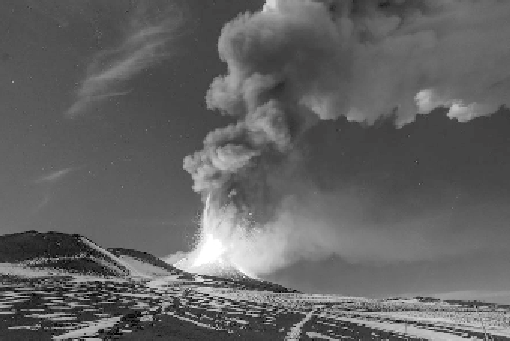Environmental Engineering Reference
In-Depth Information
Figure 11.2 Etna, Sicily, on 10
11 November 2013, during which the volcano
produced new basaltic scoria cones,
-
intense lava fountains, plumes and
lava
flows. (Photo: Tom Pfeiffer, VolcanoDiscovery).
a buoyant plume estimated to rise to 11 km ASL (7.5 km above the vent)
(Smithsonian Institution,
1984
).
Much larger
fire-fountains were documented during the 1986 basaltic
ssure
eruption of Izu-Oshima volcano, Japan, and, indirectly, the 1783
1784 eruption of
Laki, Iceland (the closest historic analogue to CFB volcanism). At Izu-Oshima,
lava fountains 1.6 km high were observed to feed an ashy sub-Plinian plume that
reached 16 km altitude (Endo
et al
.,
1988
; Mannen and Ito,
2007
). Thordarson and
Self (
1993
) estimated that Laki
'
s fire-fountains reached 0.8
-
1.4 km in height,
sustaining eruption columns of up to 15-km altitude, based on historical reports
from contemporary observers. Glaze
et al
. (in press) have modelled the observed
maximum plume heights (12
-
16 km ASL) for the 1986 Izu-Oshima eruption
(
Figure 11.3
). The model predicts maximum plume heights of 13.1
-
-
17.4 km for
source vent widths of between 4 and 16 m (consistent with expected
re-fountain
widths) when 32% (by mass) of the erupted magma is fragmented and involved
in the buoyant plume (effective volatile content of 6 wt%). The amount of ash in
the plume is important, in part because solid particles store heat more effectively
than gas.
11.2.2 Flood basalt eruption plumes
Field observations suggest that the Miocene-age Roza eruption (14.7 Ma, part of
the CRBG) could have had sustained
fire-fountains of similar height to Izu-Oshima
(
~
1.6 km above the vent; Thordarson and Self,
1996
;
1998
). Assuming 5-km-long

